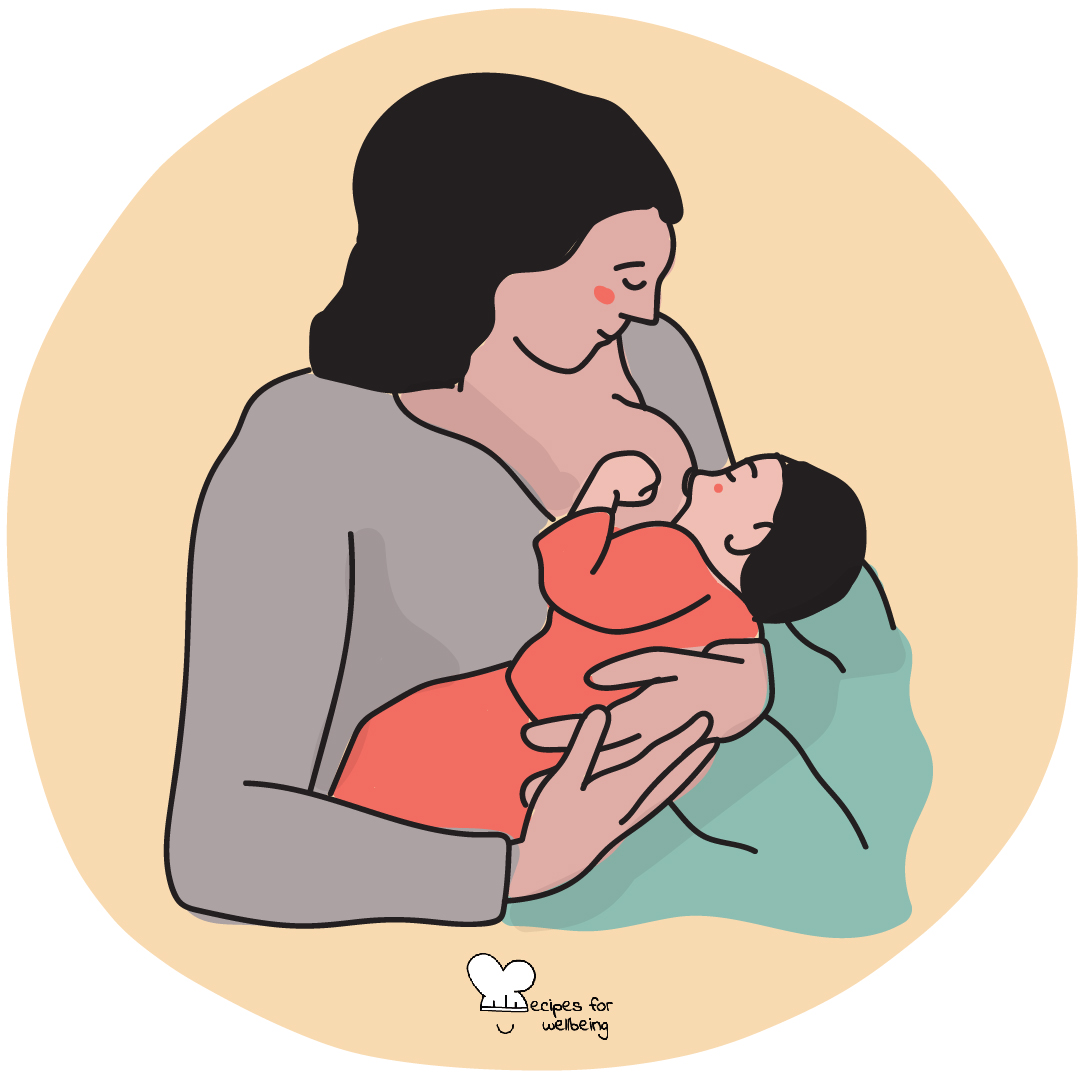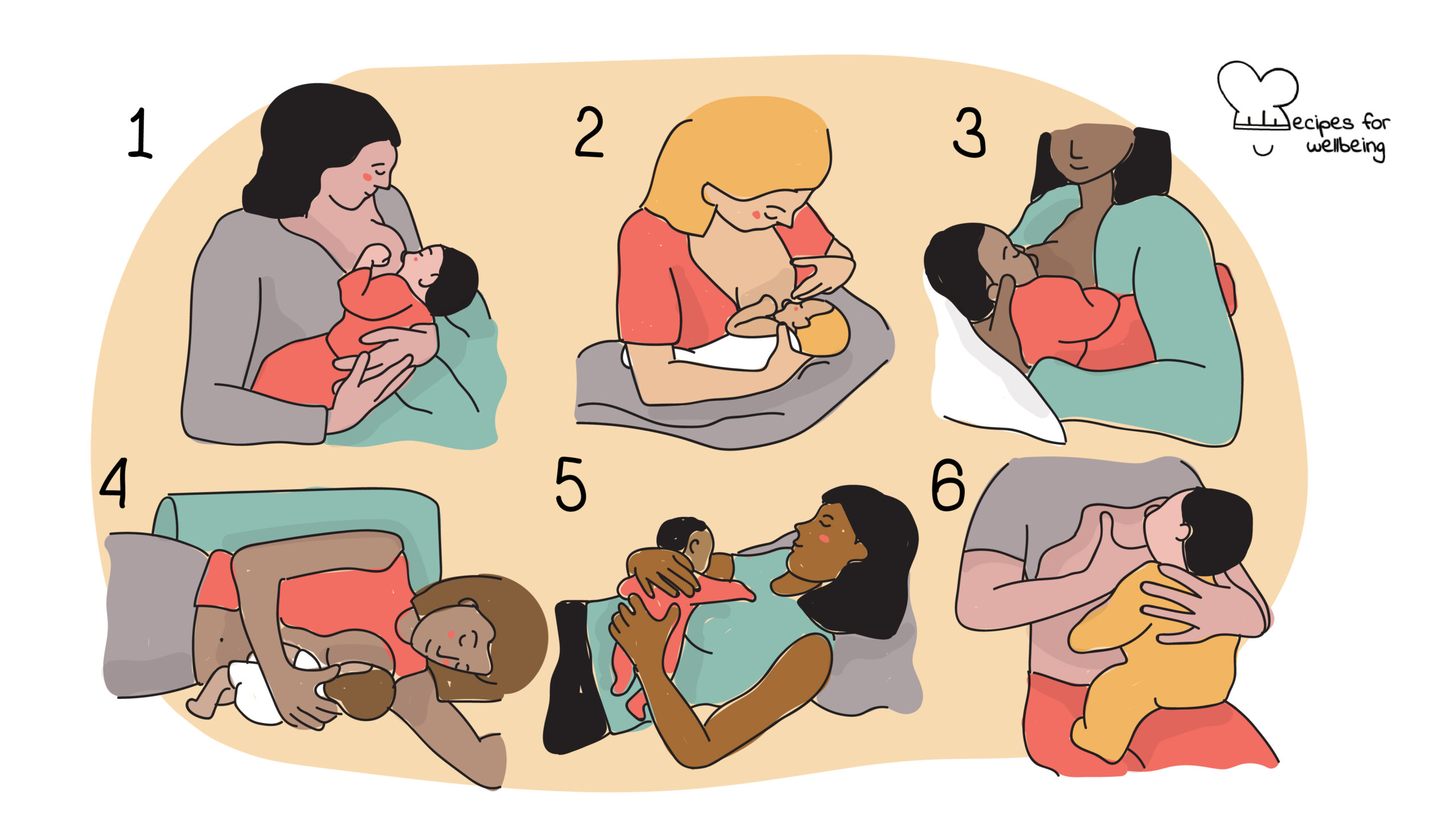
Breastfeeding positions
Your breastfeeding journey matters.
👥 Serves: 1 person
🎚 Difficulty: Easy
⏳ Total time: Ongoing
🥣 Ingredients: A place where you can sit comfortably, a breastfeeding pillow or several pillows, a pouffe to raise your legs, water and snacks (for you), a small cloth or towel for unwanted spills
🤓 Wholebeing Domains: Radical Care, Rest, Ritualising
💪 Wholebeing Skills: Caring, Embodiment, Giving, Hosting yourself, Pausing, Ritualising, Seeking support

Breastfeeding positions
📝 Description
Tips on different positions to adopt to support breastfeeding.
Breast milk is something quite extraordinary. In the book Like a Mother, Angela Garbes explains what makes breast milk so incredible:
- It contains all the vitamins, proteins, fat, carbohydrates, and nutrients a baby needs in their first six months of life.
- It also contains germs- and disease-fighting substances that help protect a baby from illness, or recover more quickly when ill.
- Its nutritional and immunological components change every day, adapting to the specific needs of a baby. In fact, it is very much alive.
- Additionally, it plays a role in regulating a baby’s circadian rhythm, helping them understand certain hours from others, night from day.
- Finally, it is a special bonding moment between mother and baby.
Despite the numerous advantages of breastfeeding, it has its costs – from time to bodily autonomy. Unfortunately, many mothers lack the societal, institutional, and cultural support structure to meet their breastfeeding goals. The following recipe presents various breastfeeding positions that can facilitate the process and outcomes for the mother and baby.
🤱 Positions
Position 1 – Cradle hold
In the cradle hold, you use the arm nearest to the breast you are nursing from to hold your baby’s body. For instance, if nursing from the right breast, you hold your baby’s body with your right arm, gently cradling their back with your forearm. Always make sure you are tummy to tummy and their nose is at your nipple’s height. This position allows you to use the other arm to support your breast or shape your nipple to facilitate the latching.
Position 2 – Cross-cradle hold
The cross-cradle hold is a variation of the cradle hold if your breast or baby needs extra support. It basically means holding your baby’s body with the opposite arm from the breast you are nursing from. For instance, if you are nursing from the right breast, you will use the left arm to hold your baby and use the right hand to support your right breast.
Position 3 – Football or rugby hold
The football or rugby hold can be particularly helpful for mothers after a C-section because it removes the weight of your baby from your lap and incision. It can also be useful if your baby latches well on one side only because it gives them the impression that they are latching from the same breast (as if you were using the cradle hold). Finally, it is a favourite for mothers of twins!
The position consists in holding your baby on the side of your body, with your arm supporting their back and your fingers gently supporting their neck. You can use the other hand to support your breast as you latch them on. Many mothers find it helpful to use a pillow to support the baby’s body.
Position 4 – Side-lying position
The side-lying position is particularly useful when you feel tired or are nursing at night, so it can be done in bed! First, ensure that the surface of the bed (or sofa) is free from pillows or extra blankets. Lie on your side and position your baby on their side, so you are tummy to tummy and their nose at your nipple’s height. You can support your neck with pillows and use your free arm to support your baby.
Position 5 – Laid-back breastfeeding
Similar to the previous position, the laid-back breastfeeding allows you to rest a little more. Also, this position allows your baby to apply their biological instincts to feed. Basically, you lean back – supported by pillows, the side of a couch, or a recliner – and you place your baby directly on your chest, belly down. You can either let your baby crawl up to the breast themselves or gently help them find the breast.
Position 6 – Koala hold
The koala hold is suitable for older babies who have some degree of control over their head and neck. This position is also helpful for babies who are reflux or have trouble keeping up with your flow. In this position, you are sitting straight with your baby sitting upright, straddling your leg. You can use the arm nearest to the breast you are feeding from to support the baby’s back, whereas the other hand can be used to support your breast.

